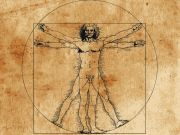- Skip Storing This Everyday Product in the Fridge Door
- Green Tea + B3 Pairing May Boost Brain Health
- Navigating Your Midlife Crisis: Embracing New Possibilities
- City Raccoons Showing Signs of Domestication
- Mapping the Exposome: Science Broadens Focus to Environmental Disease Triggers
- One Week Less on Social Media Linked to Better Mental Health
- Your Brain Changes in Stages as You Age, Study Finds
- Some Suicide Victims Show No Typical Warning Signs, Study Finds
- ByHeart Formula Faces Lawsuits After Babies Sickened With Botulism
- Switch to Vegan Diet Could Cut Your Greenhouse Gas Emissions in Half
Leonardo’s ‘Vitruvian Man’ Ideal Isn’t Far Off Modern Measures

More than five centuries ago, Renaissance master Leonardo da Vinci produced a now-famous image of what he considered the perfectly proportioned male body: the “Vitruvian Man.”
The drawing was inspired by even earlier pondering on the perfect human form by first-century A.D. Roman architect Vitruvius.
Now, work done by American scientists involving high-tech scans of the bodies of almost 64,000 fit young men (and some women), finds that Leonardo got very close to anatomical measurements collected today.
“Despite the different samples and methods of calculation, Leonardo da Vinci’s ideal human body and the proportions obtained with contemporary measurements were similar,” reported a team led by Diana Thomas, a mathematician at the U.S. Military Academy in West Point, N.Y.
“Vitruvian Man” is an iconic drawing by Leonardo from 1490 in which an adult male stands, legs together and then apart, inside a circle and square whose borders end at his head, outstretched hands and feet. It’s meant to depict the ideal adult male body.
But how close did Leonardo get to reality? To find out, Thomas and her colleagues had thousands of highly fit U.S. Air Force training recruits, ages 17 to 21, undergo high-tech 3D body scanning to determine average measurements.
For good measure, a separate sample of almost 1,400 female recruits were also scanned — the artist did not produce a “Vitruvian Woman,” however.
The results? “Except for arm span and thigh length, the differences in proportions for men measured by the body scanner and ‘Vitruvian Man’ were within 10% [concurrence],” the West Point researchers said. “The difference in arm span was 20% and difference in thigh height was 29% more than ‘Vitruvian Man.'”
That means that when placed inside the perfect circle and squares created by Leonardo, today’s “ideal” man’s fingers and toes slightly exceed those boundaries.
Still, Thomas’ group gave the Renaissance genius some slack, noting that in the 15th century, scientific calculations of population averages simply didn’t exist, and Tuscan men’s measurements could very well differ from those of today’s young American men.
Also, “Leonardo da Vinci’s notes and conclusions did not distinguish whether his insights were derived from a single individual or were aggregated,” the researchers said. It’s not even clear what reference measurement points on the male body Leonardo was working with.
Still, despite all this, “close agreement” was still found in the images created 500 years ago by one man, and those created in 2020 by a much more complex scientific analysis, Thomas and her colleagues said.
The study was published June 9 in the Journal of the American Medical Association.
More information
For more on “Vitruvian Man,” see Stanford University.
Source: HealthDay
Copyright © 2025 HealthDay. All rights reserved.










